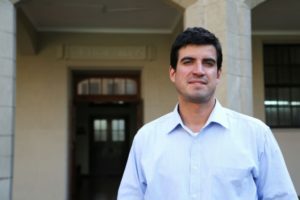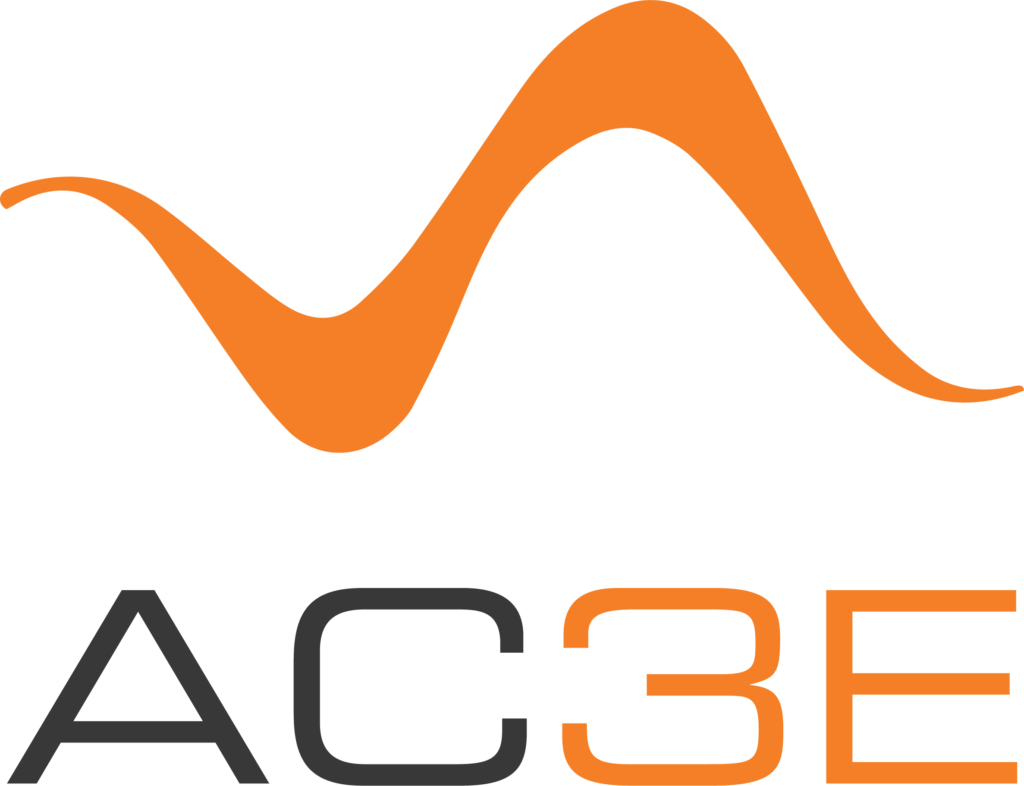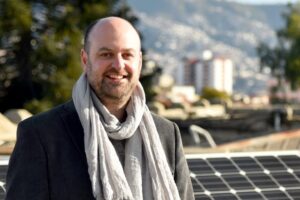[:es] El profesor Juan Yuz, actual Subdirector, reemplazará a José Rodríguez, quien deja su cargo, pero seguirá siendo investigador asociado de la entidad, que posee un fuerte componente de investigación aplicada, motivada por los requerimientos de la industria.
El profesor Juan Yuz, actual Subdirector, reemplazará a José Rodríguez, quien deja su cargo, pero seguirá siendo investigador asociado de la entidad, que posee un fuerte componente de investigación aplicada, motivada por los requerimientos de la industria.
El académico Juan Yuz ha sido nombrado como el nuevo Director del Centro Avanzado de Ingeniería Eléctrica y Electrónica AC3E de la Universidad Santa María, en reemplazo del profesor José Rodríguez. Este último continuará ligado a él como investigador asociado en la línea de Conversión de Energía y Sistemas de Potencia, que lideran el profesor Samir Kouro y el investigador Marcelo Pérez, donde también participan destacados investigadores de otras universidades tales como la U. de Valparaíso, U. de Concepción, Pontificia U. Católica de Chile, U. de Chile y U. Diego Portales, a la que ahora se suma la U. Andrés Bello.
A cargo de este equipo conformado por expertos tanto de la USM como otros seis planteles nacionales, el académico Juan Yuz no duda de que está al frente de un gran desafío, “pero lo asumo con la tranquilidad que da la gran calidad científica, profesional y humana de todo el grupo de personas detrás de este proyecto”, sentencia. “Más que el rol que me corresponde desempeñar en lo personal como Director del Centro, creo que es este grupo humano lo fundamental para el éxito de una iniciativa como esta, de largo plazo y de esta magnitud, tanto por los objetivos que nos hemos planteado como por la cantidad de fondos que nos ha entregado CONICYT”.
El organismo estatal ya está al tanto del cambio de director, el cual será oficializado dentro de las próximas semanas. “Este es el segundo centro con financiamiento basal que se adjudica la Universidad”, explica Juan Yuz. “El Centro Científico Tecnológico de Valparaíso (CCTVal) funciona desde el año 2009 y varios de los investigadores del AC3E fuimos parte de él. Ambos son muy importantes para nuestra Universidad, pues claramente contribuyen a crear conocimiento, al desarrollo científico y tecnológico del país, y a formar profesionales del más alto nivel, tres ejes que son clave en nuestra misión institucional”.
Asimismo, si bien el AC3E está basado en los Departamentos de Electrónica e Ingeniería Eléctrica, su nuevo director distingue que “este es un proyecto con una fuerte orientación a la aplicación, que ha sido un sello en la formación de nuestros estudiantes; eso unido a la investigación de excelencia, permitiría realizar transferencia tecnológica, innovación y emprendimiento que seguirá posicionando el sello USM en la industria y sociedad chilenas, y también a nivel internacional”.
El profesor recalca que la Universidad ha reconocido la importancia de estos Centros, entregando un decidido apoyo en términos de recursos e infraestructura.
Un apoyo a la industria
El Centro AC3E tiene como objetivo el desarrollo de proyectos de investigación e innovación, motivados por desafíos específicos de la industria nacional en ámbitos como la minería y la agricultura, así como las energías renovables y aplicaciones en sistemas biomédicos.
“Nuestra postulación original fue respaldada por empresas como Abengoa Research, Andes Minerals y varias otras. En este corto período que llevamos de ejecución del Centro desde octubre pasado, hemos firmado convenios con otras instituciones tales como Clínica Ciudad del Mar y Teletón, en el ámbito de sistemas biomédicos, y empresas como Aguas Andinas y SisDef. Estos proyectos que recién empiezan se suman a la larga lista de proyectos científicos que llevan adelante investigadores del Centro. Muestra de esto es, por ejemplo, la adjudicación de 8 nuevos proyectos en el último Concurso Regular de FONDECYT por parte de investigadores del AC3E”.
En lo inmediato, el reto principal que enfrenta el Centro es dotarse de la estructura necesaria para el desarrollo de proyectos de innovación e investigación aplicada, construir una plataforma que les permita a sus reconocidos investigadores ampliar el impacto de sus actividades de investigación y hacer transferencia tecnológica hacia el sector productivo.
“Una de las razones por las cuales la postulación del Centro obtuvo el primer lugar en la convocatoria de CONICYT en financiamiento basal, es el cambio de paradigma que propone respecto a cómo conducir la investEquipo Centro AC3Eigación y desarrollo tecnológico con una mirada más interdisciplinaria, para estar a la altura de los desafíos de la Industria”, señala. “Es por ello que el AC3E ha presentado un proyecto de infraestructura a la Universidad que permitiría contar con los espacios adecuados para poder potenciar la sinergia entre las distintas líneas de investigación y, de esa manera, poder brindar soluciones multidisciplinarias a problemas que son inherentemente de esa naturaleza”.
Y agrega que la industria actual además “exige soluciones y prototipos a escalas reales o más cercanas a la práctica, para lo cual contar con los espacios adecuados que puedan brindar un espacio efectivo y seguro de trabajo resulta ser de vital importancia”.
Hasta el momento, la Universidad ha respaldado a AC3E en términos de espacio físico adicional a los laboratorios de investigación disponibles al momento de postular el proyecto, y también se ha avanzado en la discusión para la construcción de un edificio cofinanciado con recursos del Centro y fondos centrales USM.
Fuente: Dirección de Comunicaciones USM[:en] Professor Juan Yuz, current Sub director, is replacing José Rodríguez, who will be leaving his position but will remain an associated researcher of this organization that possesses a strong applied research component, moved by industry requirements.
Professor Juan Yuz, current Sub director, is replacing José Rodríguez, who will be leaving his position but will remain an associated researcher of this organization that possesses a strong applied research component, moved by industry requirements.
Academic Juan Yuz has been elected as the new Director of the Advanced Center for Electric and Electronic Center (AC3E) from Universidad Santa María, in replacement of Professor José Rodríguez. Professor Rodríguez will remain part of the center as an associated researcher in the Energy Conversion and Power Systems, led by Professor Samir Kouro and researcher Marcelo Pérez, in which renowned researchers from other universities such as Universidad de Valparaíso, Universidad de Concepción, Pontificia Universidad Católica de Chile, Universidad de Chile Universidad Diego Portales and Universidad Andrés Bello participate.
Academic Juan Yuz, in charge of this team made up of experts from USM and other 6 campuses, has no doubts that he has a big challenge ahead of him, “but I bear it with the calmness provided by the great scientific, professional and human quality from everyone behind this project”, he says. “I think the key to the success of a long term initiative of this magnitude is the human group more than my role as the center’s director, in terms of the objectives we’ve established and the funding received from CONICYT.”
This government organization is aware of the change in director, who will be formalized within the next weeks. “This is the second center with basal funding that has been awarded to the USM”, Juan Yuz explains. “The Valparaíso Technologic Scientific Center (CCTVal) has been functioning since 2009 and several researchers from AC3E formed part of it. Both are very important to our campus, since they clearly contribute in creating knowledge, scientific and technologic development, and in training high quality professionals, 3 aspects that are fundamental in our institutional mission.
Furthermore, even though the AC3E is based in the Electronics Department and Electrical Engineering, its new director distinguishes that “this a project with strong orientation to application, which has been a seal in the training of our students; this in addition to the excellence in research, will allow the technological transfer, innovation and entrepreneurship to keep positioning the USM seal in the industry and the Chilean society, as well as internationally.
The professor emphasizes that the University acknowledges the importance of these centers, providing support in terms of resources and infrastructure.
Supporting the Industry
The AC3E’s main objective is the development of research and innovation projects, moved by specific challenges provided by the national industry in fields such as mining and agriculture, as well as renewable energies and applications in biomedical systems.
“Our original proposal was supported by companies such as Abengoa Research, Andes Minerals and several others. In this short period that the center has been functioning since last October, we’ve signed agreements with other institutions such as Clínica Ciudad del Mar and Teletón, in the biomedical systems field, and companies such as Aguas Andinas and SisDef. In addition to these projects that are just starting, there is a long list of scientific projects pushed forward by researchers from the Center. For example, a proof of this is the appointment of 8 new projects in the last “Concurso Regular de FONDECYT” by AC3E researchers.”
At the moment, the main challenge that the Center faces is implementing the necessary structure for the development of applied research and innovation, building a platform that allows their renowned researchers to broaden the impact of their research activities and technological transfer to the manufacturing sector.
“The main reason why the Centers proposal won first place in the call made by CONICYT in basal funding, is the proposed shift in paradigm on how to conduct a research and technological development with a more interdisciplinary outlook, to live up to the industries challenges”, he points out. “This is why the AC3E has presented an infrastructure project to the University that will allow to them to count with the necessary spaces in order to boost the synergy between all the research lines and this way, be able to give multidisciplinary solutions to problems inherently of this nature.”
He adds that the current industry “demands solutions and real scales prototypes or at least more practical ones, to which having adequate spaces that can provide an effective and secure work space becomes of vital importance”.
To the moment, the University has backed the AC3E in terms of physical space in addition to the research labs available at moment of applying. We have also pressed forward in the discussion for the construction of a building co-funded by resources from the Center and USM funds.
Fuente: Dirección de Comunicaciones USM
[:]









